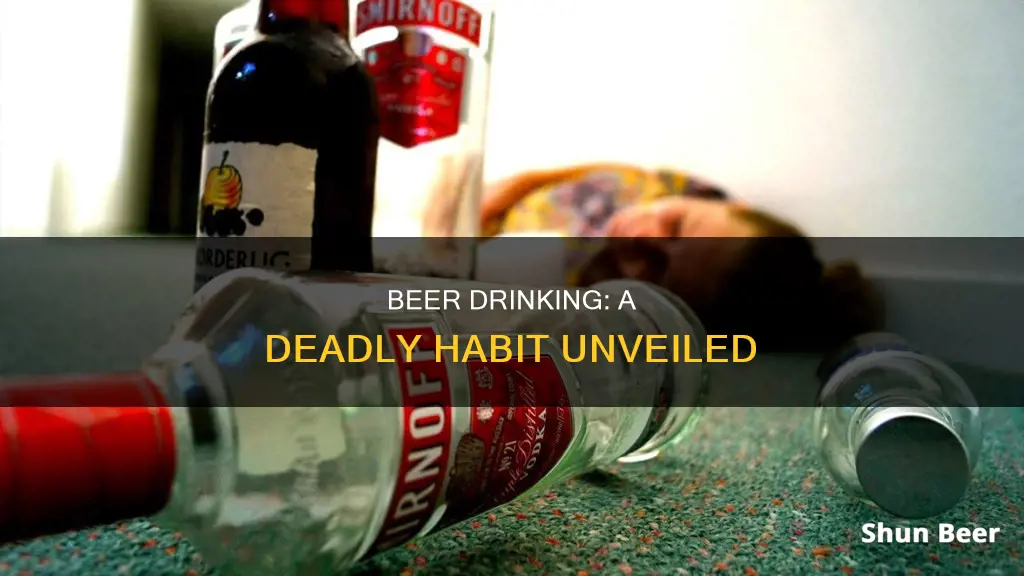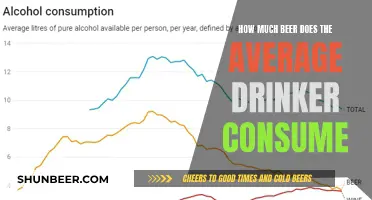
Drinking beer can kill you. While beer has a lower alcohol content than other alcoholic drinks, excessive consumption can lead to alcohol poisoning, which can be fatal. Alcohol poisoning occurs when the liver becomes overwhelmed and vital body systems shut down, affecting heart rate and body temperature. Binge drinking and long-term alcohol abuse can also lead to severe health issues, including liver disease, heart disease, cancer, and memory and learning problems. Additionally, drunk driving is a serious issue, causing thousands of deaths each year. It is important to drink responsibly and be aware of the potential risks associated with alcohol consumption.
| Characteristics | Values |
|---|---|
| Alcohol poisoning | Occurs when people drink too much in a short period of time |
| Liver disease | Fatty liver disease, alcoholic hepatitis, cirrhosis |
| Cancer | Breast, throat, liver, colon, oesophagus, mouth |
| Heart disease | High blood pressure, obesity, high cholesterol |
| End-stage alcoholism | Cells lose the ability to regenerate, liver struggles to supply essential nutrients, complications in the central nervous system |
| Drunk driving | Alcohol-related driving fatalities accounted for approximately 10,000 deaths in 2014 |
What You'll Learn

Alcohol poisoning
The kidneys and liver can only metabolise alcohol at a certain rate. A healthy liver can process around one ounce of liquor per hour, but many people consume far more than this when drinking. If you drink too much, too quickly, your liver will be overwhelmed, and vital body systems will start to shut down.
Anyone can be affected by alcohol poisoning, regardless of their alcohol tolerance, weight, age or gender. It is important to note that binge drinking significantly increases the risk of alcohol poisoning. Binge drinking is defined as a drinking pattern that brings blood alcohol concentration (BAC) to 0.08% or higher. This typically occurs after a woman consumes four drinks or a man consumes five drinks in about two hours.
The symptoms of alcohol poisoning include mental confusion, difficulty remaining conscious, vomiting, seizures, trouble breathing, slow heart rate, clammy skin, dulled responses (such as no gag reflex, which can lead to choking), and extremely low body temperature.
If you suspect someone is experiencing alcohol poisoning, seek medical attention immediately. Do not try to self-treat the symptoms, as this can cause more harm than good. Call 911 for help right away and, while waiting for medical assistance to arrive, keep the person in an upright sitting position and make sure they stay awake.
Beer and Fasting: Can They Coexist?
You may want to see also

Liver disease
Alcohol-related liver disease (ARLD) refers to liver damage caused by excess alcohol intake. ARLD has several stages of severity and a range of associated symptoms. The liver is one of the most complex organs in the body, performing functions such as filtering toxins from the blood, aiding digestion, regulating blood sugar and cholesterol levels, and helping fight infection and disease.
Each time the liver filters alcohol, some of its cells die. While the liver can develop new cells, prolonged alcohol misuse over many years can reduce its ability to regenerate, resulting in serious and permanent liver damage. ARLD is very common in the UK and the number of people with the condition has been increasing over the last few decades due to rising levels of alcohol misuse.
There are three main stages of ARLD:
- Alcoholic fatty liver disease: This is the first stage of ARLD and occurs when drinking a large amount of alcohol, even for just a few days, leads to a build-up of fats in the liver. Fatty liver disease rarely causes any symptoms but is a warning sign that an individual is drinking at a harmful level. This stage is reversible if the individual stops drinking alcohol for several weeks to a few months or years.
- Alcoholic hepatitis: Alcoholic hepatitis is a potentially serious condition that can be caused by alcohol misuse over a longer period. It may be the first time a person becomes aware that they are damaging their liver through alcohol consumption. In mild cases, liver damage occurs slowly over many years, but severe alcoholic hepatitis can come on suddenly, such as after binge drinking, and can be life-threatening. This stage is usually reversible if the individual stops drinking permanently, but severe cases may require a liver transplant.
- Cirrhosis: Cirrhosis is a stage of ARLD where the liver has become significantly scarred. Even at this stage, there may not be any obvious symptoms. Cirrhosis is generally not reversible, but stopping drinking alcohol immediately can prevent further damage and significantly increase life expectancy. A person with alcohol-related cirrhosis who does not stop drinking has a less than 50% chance of living for at least five more years.
The main treatment for ARLD is to stop drinking alcohol, preferably for the rest of one's life. This reduces the risk of further liver damage and gives the liver the best chance to recover. However, stopping drinking can be challenging, especially since it is estimated that about 70% of people with ARLD have an alcohol dependency problem. Support, advice, and medical treatment may be available through local alcohol support services. In severe cases where the liver has stopped functioning and does not improve when an individual stops drinking, a liver transplant may be required.
Bees and Beer: A Buzzing Friendship?
You may want to see also

Heart disease
Excessive alcohol consumption and alcoholism increase the probability of dying from heart conditions. Drinking is linked to high blood pressure and obesity, both of which are contributing factors to heart disease. Additionally, alcohol increases the level of triglycerides (harmful fats) in the blood, which can result in high blood pressure, increased caloric intake, and heart failure.
In the long term, the development of heart disease due to alcoholism can lead to stroke, sudden cardiac death, and cardiomyopathy. Cardiomyopathy is a disorder that affects the heart muscle, and regular or high alcohol use can contribute to this. Binge drinking, defined as four or more drinks for women and five or more for men in about two hours, can cause irregular heart rhythms called arrhythmias.
However, some studies have shown that moderate alcohol intake may reduce the risk of heart disease. A study by Israeli researchers found that drinking one beer (12 ounces) a day for a month produced changes in blood chemistry associated with a reduced risk of heart attack. These changes include decreased cholesterol levels, increased antioxidants, and reduced levels of fibrinogen, a clotting protein. However, doctors are unsure if these healthy effects are due to alcohol or other lifestyle choices that light drinkers make. Exercise can also boost HDL cholesterol levels, and antioxidants can be found in other foods such as fruits, vegetables, and grape juice.
Drinking Beer While Taking Zyrtec: Is It Safe?
You may want to see also

Cancer
Drinking beer can increase the risk of developing certain types of cancer. Alcohol is a toxic substance and is linked to an increased risk of several cancers, contributing to about 5.5% of all new cancer diagnoses and 5.8% of all cancer-related deaths, according to the National Institutes of Health (NIH).
The type of alcohol consumed does not matter—it is the alcohol itself that causes the damage. Alcoholic beverages contain ethanol, which the body breaks down into acetaldehyde, a known carcinogen. This compound damages DNA and prevents cells from repairing this damage, allowing cancerous cells to grow.
The risk of cancer increases with the amount of alcohol consumed. Even small amounts of alcohol can increase the risk of breast cancer, for example. The American Cancer Society also notes that consuming small amounts of alcohol can increase the risk of breast cancer. Alcohol consumption is also associated with an increased risk of throat, colon, mouth, and laryngeal cancers.
In addition to the direct effects of alcohol, drinking beer can also worsen the effects of other carcinogens. For example, drinking alcohol can make cells in the mouth and throat more susceptible to absorbing harmful chemicals found in tobacco smoke, increasing the risk of mouth and upper throat cancers.
The link between alcohol consumption and cancer is well-established, and the risk of cancer increases with each drink. While drinking in moderation can reduce the risk, the greatest risk reduction comes from abstaining from alcohol completely.
Ginger Beer and Breastfeeding: Is It Safe to Drink?
You may want to see also

Drunk driving
Drinking beer can have fatal consequences, and one of the most prominent ways it can lead to death is through drunk driving. Driving under the influence of alcohol is a serious issue that claims countless lives each year. According to statistics, every 79 seconds, someone is killed or injured in a drunk driving crash in the United States. In 2021, there was a staggering number of 13,384 people who lost their lives in alcohol-impaired driving crashes, representing a 14% increase from 2020. This alarming trend shows no signs of abating, with drunk driving deaths having risen by 31% since 2019.
Alcohol impairs an individual's decision-making, coordination, and reaction time, making it extremely dangerous to get behind the wheel of a car. Even a small amount of alcohol can have a significant impact on driving ability. Studies have shown that drivers with a blood alcohol content (BAC) of just 0.02 to 0.05% are seven times more likely to die in a crash compared to sober drivers. As alcohol consumption increases, the likelihood of a crash and the severity of injuries also rise.
The legal limit for driving under the influence varies by state, but in all 50 states, it is illegal to drive with a BAC above the state's limit. Despite this, many people still make the reckless decision to drink and drive. According to self-reported data, American adults admit to 111 million cases of alcohol-impaired driving each year. While only 1% of these drunk drivers are arrested, the true scale of the problem is evident in the number of lives lost. Every day, approximately 29 people die in car accidents involving drunk drivers, and in 2016, alcohol was a factor in 28% of all traffic-related deaths in the nation.
Beer and Diverticulitis: What You Need to Know
You may want to see also
Frequently asked questions
A lethal dose of alcohol depends on factors such as tolerance, gender, age, weight, and any medical conditions. For an average adult male, a lethal dose is typically between 5 and 8 grams of alcohol per kilogram of body weight.
Binge drinking can lead to alcohol poisoning, which is life-threatening. Signs of alcohol poisoning include extremely low body temperature, dulled responses to stimuli, irregular or slow breathing, unconsciousness, and inability to wake up.
Frequent binge drinking or long-term alcohol abuse can lead to organ failure and death. Some long-term impacts include cancer, memory and learning problems, anxiety, depression, liver disease, and heart disease.







